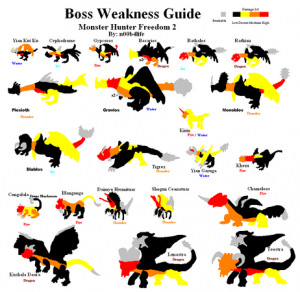 Monster Hunter Freedom Unite is a 2008 video game in the Monster Hunter franchise for PlayStation Portable: (Trailer). The title of the game tells players exactly what they are going to spend all their time doing. Basically answering the key question of what is this game about.
Monster Hunter Freedom Unite is a 2008 video game in the Monster Hunter franchise for PlayStation Portable: (Trailer). The title of the game tells players exactly what they are going to spend all their time doing. Basically answering the key question of what is this game about.
The LENS of CURIOSITY seeks to prompt players with questions. “I’m hunting monsters? Seriously”
Questions inevitably surface in players minds. More so as they get familiar with the game: Monster’s weaknesses, attack patterns, movements, carving drops and most importantly how to bring them down. Combined with vast variety of options in the form of monsters, terrain, equipment, carves, weapon styles and challenges. There is no lacking in probable questions.
There are literally hundreds of items for player’s disposal, including eleven weapon-types, with attack powers and buffs. Hence, players get to ponder on the how(s) and what(s) to achieving combinations to complement their individualistic and personalized styles. The game motivates curiosity such that it never gets boring, even after thousands of hours of game play.
Analyzing the game play of this game is described by the LENS of SKILL.
Monster hunter sits in the middle of being a “casual game” and a “hardcore game”; it is easy to play, yet difficult to master. The level of strategy involved is as deep as the combined imaginations of up to four simultaneous players. All made possible with its controls. The steep skill curve makes the balance in the LENS of SKILL questionable.
Unlike most role playing games, this game is nothing about numbers; players should be able to venture cold into any hunt with only the weakest weapon in the game and yet slay everything in his/her path. That is the level of skill achievable; timing, precision and movement. The more one plays the better he/she gets.
However contesting players for such proficiency at an early stage in the game experience could be a disincentive. A player unable to handle the learning curve quickly dismisses the game. It can be just too difficult or laborious to achieve. But anything that falls short of in virtuoso skill can be subtly convinced or gloriously feigned through cooperation with peers.
Discussing synergy among peers as mentioned in the LENS of COOPERATION.
 The prime factor where monster hunters earn its fans is indisputably, when players try their hands on the multiplayer gameplay. Via the PlayStation Portable’s Ad-Hoc functionality, players are enabled to experience the social gaming phenomenon, unlike the MMORPG Games, and adventure in up to a party of four for a thrilling and savaging multiplayer hunting party.
The prime factor where monster hunters earn its fans is indisputably, when players try their hands on the multiplayer gameplay. Via the PlayStation Portable’s Ad-Hoc functionality, players are enabled to experience the social gaming phenomenon, unlike the MMORPG Games, and adventure in up to a party of four for a thrilling and savaging multiplayer hunting party.
Monster hunter fully capitalizes on the amazing potential of local multiplayer, and succeeded in thoroughly exploiting it; Perfect communications setting, where players are in the immediate vicinity yelling and laughing at one another, friends and strangers bonded by the display of skill and reliance.
In single mode, the player is allowed 3 deaths before the quest is over. In co-op mode, the total number of deaths between players is three then everyone’s quest is over. Such a challenge promotes cohesiveness; Players knocking heads, wrecking brains, devising a strategy to slay the monster. Team play is the key to hunting down those ferocious beasts. Monster Hunter miraculously manages never to feel lonely or fruitless. But isn’t the game appearing to be overly repetitive?
Players experience an unconventional form of progress, discussed in the LENS of VISIBLE PROGRESS.
Players repeat tasks, over and over, honing their skills and upgrading their equipment. Mission structures higher skill rated missions, reusing repeated locations but with stronger or different patterns of more monsters. Monsters possess varied, albeit predictable, AI patterns that are still interesting enough to entertain. And one would ask, “Does it ever end?”
The player’s character is constantly changing: constantly scavenging and crafting new items, trinkets, pieces of clothes or armor; weapons get shinier and sharper, but most importantly players get better at playing the game. Because skill is in question, there is always the ability to improve, as players tackle quests they discover new and amazingly different approaches.
The experience is, to say the very least, far more psychologically fulfilling than in other forms of progression: Players progress as a hunter more so than progress in the game. The repetition, often unwanted in games, isn’t a problem no matter the number of times, players always relish the monster’s falling moment, screaming its last cry.
“Can this really be fun?” In the LENS of FUN, it is asked.
Monster Hunter has essentially no complex story line other than a clichéd explanation of the player’s origin. But considering the nature of the game that flows hence forth, it’s well sufficient. In a game that otherwise features no “end goal”, many feel achieved and full of iconic moments playing the game.
Hunting yields surprising options; in other games killing monsters is all too common, but here, players get to chop tails and break horns or capturing for rewards. But to do so requires timing and precision which makes the action of doing so fill the players with overwhelming joyous sensations.
The fun is exemplified more so when players do their hunts in groups. Cracking monster heads and chopping off tails with coordinated group tactics. No matter being a novice nor expert, the surprises from hunting together highlights monster hunter’s fun factor, especially those laughable moments when your peers make comedic mistakes at a costly blow.
The crux of the game is so well-grounded in a hunter’s common sense that the fun in the game is felt in the experience.

